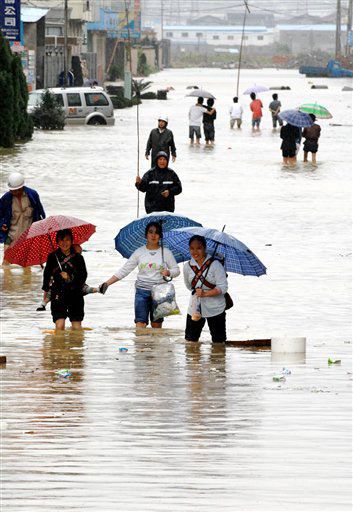Nature's Wrath in 2009 Tallied by Country

Asia took the brunt of natural disasters in 2009, experiencing more than 40 percent of Mother Nature's havoc, with the Americas coming in second, according to a new report.
The Philippines, China and the United States were the countries most often hit by notable natural disasters last year.
Overall in 2009, 335 natural disasters were reported worldwide, killing 10,655 people and affecting more than 119 million others. The economic damages from these events exceeded $41.3 billion in U.S. dollars. The number of disasters is actually down compared with the 2000-2008 annual average of 392, mostly because there were fewer storms and other meteorological disasters last year.
While there weren't any so-called mega-disasters, residents did feel the Earth shaking and burping scorching magma. The highest number of reported deaths was due to the earthquake in Sumatra, Indonesia on Sept. 30, which left 1,117 dead and more than 2.5 million others affected. The floods in July in Southern and Central China impacted the most individuals (39.4 million people).
The new report, called the Annual Disaster Statistical Review and compiled by the Centre for Research on the Epidemiology of Disasters, reveals the unequal distribution of the burden from natural disasters. For instance, from the 111 countries affected by natural disasters last year, 18 accounted for more than 75 percent of the overall reported number of deaths, victims (number killed and affected) and economic damages. The top 10 countries by number of notable natural disasters experienced in 2009 were: Philippines: 25 disaster events
- China People's Republic: 24 events
- United States: 16 events
- India: 15 events
- Indonesia: 12 events
- Brazil: 9 events
- Mexico: 7 events
- Australia: 6 events
- Bangladesh: 6 events
- Viet Nam: 6 events
The number of events doesn't tell the whole story, though, since disaster type and intensity as well as the country's infrastructure can play a role in determining the number of human victims.
Here are the top 10 countries by natural-disaster-caused mortality in 2009:
Sign up for the Live Science daily newsletter now
Get the world’s most fascinating discoveries delivered straight to your inbox.
- India: 1,806 deaths
- Indonesia: 1,407
- Philippines: 1,334
- Taiwan: 630
- China: 591
- Australia: 535
- Peru: 419
- Viet Nam: 356
- Italy: 335
- El Salvador: 275
Nature's most destructive disasters
Hydrological disasters, such as floods, remained the most common disasters in 2009, accounting for 53.7 percent of total reported natural disasters. This was followed by meteorological disasters (storms such as hurricanes), accounting for 25.4 percent of disasters; geophysical disasters (earthquakes, volcanoes) accounted for 2.7 percent of total disasters.
The 10 most destructive disasters regarding mortality included:
- Earthquake in September, which killed 1,117 individuals in Indonesia
- Flood from July-September, which killed 992 individuals in India
- Ketsana tropical storm Ondoy from September-October killed 716 individuals in the Philippines, Viet Nam, Cambodia and Lao People's Democratic Republic
- Typhoon Morakot in August killed 664 individuals in Taiwan, the Philippines and China
- Typhoon Pepeng in October killed 542 individuals in the Philippines and China
- Heat wave from January-February killed 347 individuals in Australia
- Flood from September-October killed 300 in India
- Cyclone Aila in May killed 298 individuals in Bangladesh, India and Bhutan
- Earthquake in April killed 295 individuals in Italy
- Hurricane Ida in November killed 281 individuals in El Salvador, the United States, Mexico and Nicaragua
And already Mother Nature has delivered a blow in 2010, from the catastrophic Haiti and Chilean earthquakes to the U.S. blizzard that descended on Washington, D.C., in February. In fact 2010 is already proving above average in terms of natural-disaster casualties.
- 10 Ways to Destroy Earth
- Natural Disasters: Top 10 U.S. Threats
- 101 Amazing Earth Facts
Jeanna Bryner is managing editor of Scientific American. Previously she was editor in chief of Live Science and, prior to that, an editor at Scholastic's Science World magazine. Bryner has an English degree from Salisbury University, a master's degree in biogeochemistry and environmental sciences from the University of Maryland and a graduate science journalism degree from New York University. She has worked as a biologist in Florida, where she monitored wetlands and did field surveys for endangered species, including the gorgeous Florida Scrub Jay. She also received an ocean sciences journalism fellowship from the Woods Hole Oceanographic Institution. She is a firm believer that science is for everyone and that just about everything can be viewed through the lens of science.










